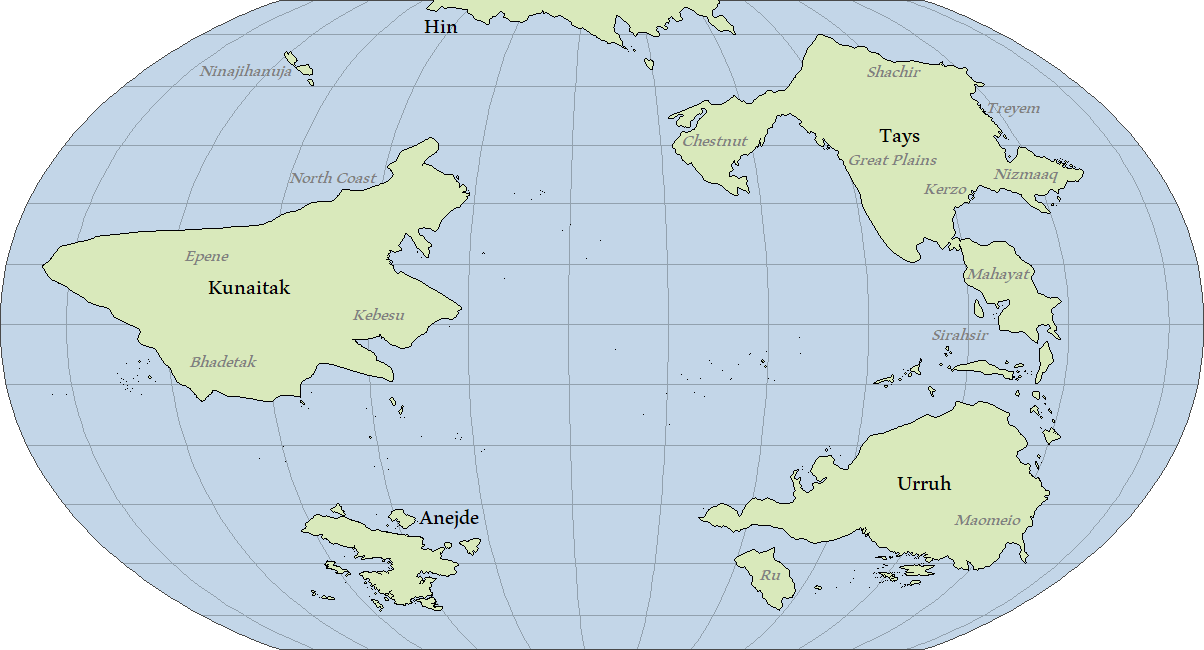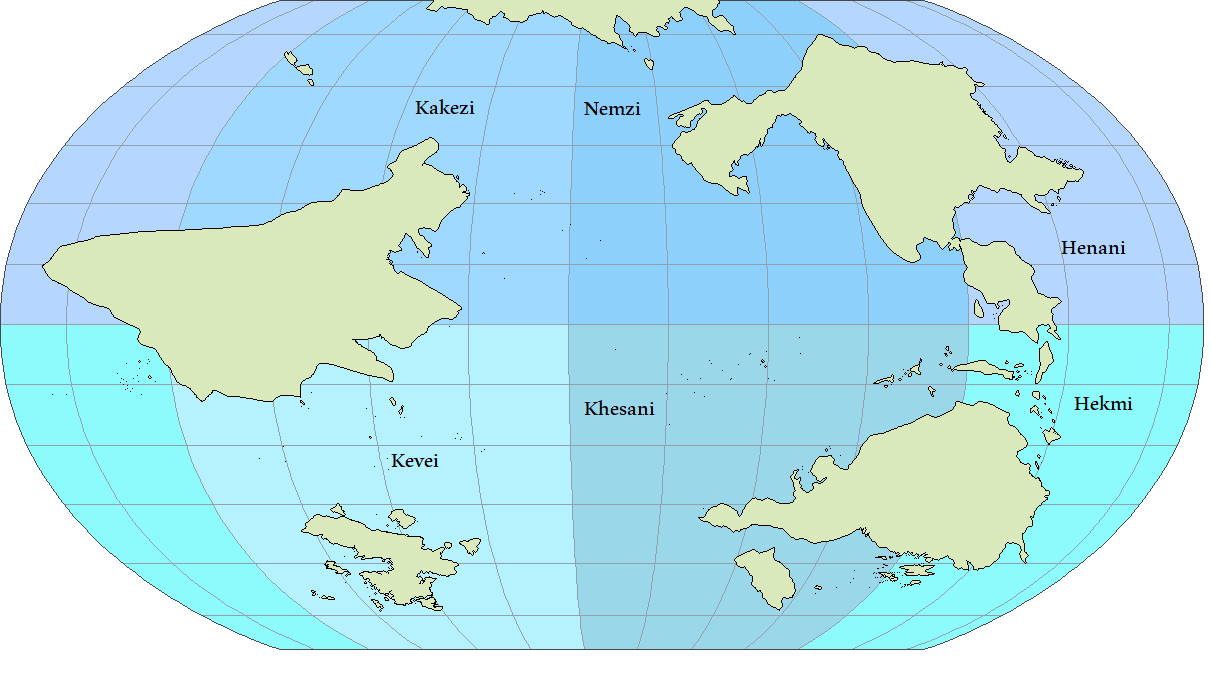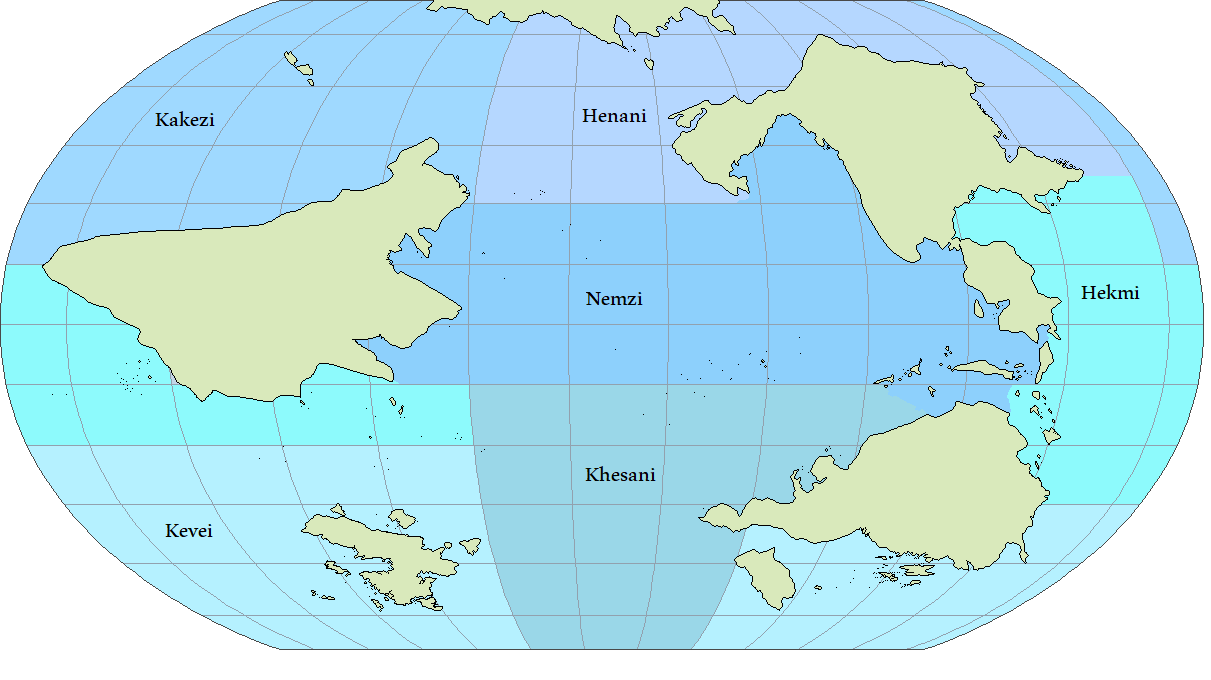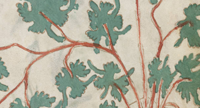the planet

Namang is a terrestrial planet. At the equator, it has a radius of 6,206km - in other words, only very slightly smaller than Earth. The average winter temperature of the North Pole is -55° C, while the average winter temperature of the South Pole is -36° C. There is one orbiting body, which we will refer to simply as "the Moon," although it is smaller than Luna (1,250km radius, in comparison to Luna's 1,737km radius). The elemental composition of both Namang and its moon are not significantly different from that of Earth and Luna.
There are five continents: Tays, Urruh, Kunaitak, Hin, and Anejde. Hin has no human residents, although it has been known for many centuries. Overall, there is less landmass on Namang than there is on Earth. For reference, Kunaitak is smaller than Eurasia; Urruh is slightly smaller than Africa; Tays is slightly larger than North America.
The highest peak is Mount Kebhidebhanga, 7.2km above sea level, on Kunaitak, in the Bhadetak mountain range.
oceans
Unlike continents, which are generally understood to be the same or similar by nearly all Namang scholars, there are vast disagreements about the classification of oceans. For clarity, we will use the Revised Metken classification. The Original Metken classification was created in 1095r by Fetkehoxus, a mathematician from the city-state of Metken. The system separated the globe into equal-sized sextants based on latitude and longitude:

However, this proved somewhat impractical for actual sailing. As the system was adopted in more countries, it was revised to fit actual trade routes, weather patterns, and political boundaries more accurately, creating the Revised Metken classification:

name etymologies
Namang: from Umehtukazu namaŋ, “equator, circumference; globe”
Tays: from Jôkhap tays, “country, border”
Shachir: from Žɣti šáćrxš, “we controlled (it)”
Great Plains: English calque of Samantayu puṇṭuhkay
Kerzo: from Jôkhap kerzo, meaning unknown
Treyem: from the Treyem Kingdom, referring to their former dominion over the region
Nizmaaq: from Meqvi (ljaahik) nizmaaq, “(the tents) rest here”
Mahayat: from Old Payadanahak mahayat, “fiefdom, appanage”
Chestnut: named after the Chestnut culture
Sirahsir: from Luruluru sirağ sir, “islands of islands”
Urruh: from Luruluru (aeağ) urruğ, “(the king’s) pasture”
Maomeio: from the name of a Na Jaeo ruler
Ru: from an unknown Southwest Channel language
Kunaitak: from Old Kondhata kunaitak, “land that goes on and on”
North Coast: English calque of Kǁhesao gǃó nǁhuy
Epene: from Bḑë é peŋë, “the desert”
Kebesu: from Proto-Tpaoso *kəbé.səó, “south of the jungle”, retained as gvêsu in Pevavimě
Bhadetak: from the Bhadetak Queendom, meaning "land of (queen) Bhade" in Jhódhóki
Anejde: from Najdi anejde, “of the Najdi”
Hin: from Kanuganajin hin, “frost”
Ninajihanuja: from Kanuganajin ni na jihanu ja, “it was carved out of stone”
Henani Ocean: from Umehtukazu henani, "first"
Kekazi Ocean: from Umehtukazu kekazi, "second"
Nemzi Ocean: from Umehtukazu nemzi, "third"
Hekmi Ocean: from Umehtukazu hekmi, "fourth"
Kevei Ocean: from Umehtukazu keveʔi, "fifth"
Khesani Ocean: from Umehtukazu xesani, "sixth"
